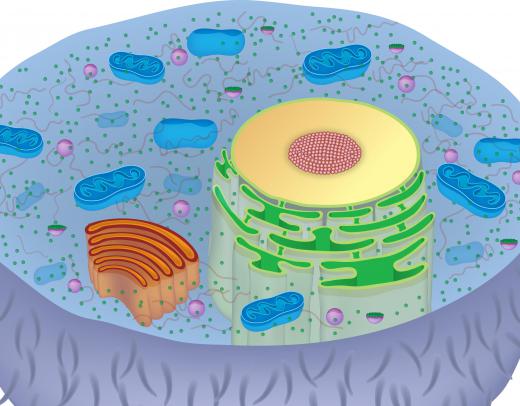What is Ribosomal RNA?
Ribosomal ribonucleic acid (ribosomal RNA or rRNA) helps to form the ribosome itself. Unlike messenger RNA (mRNA), it does not transmit genetic information. Instead, it combines with proteins to create a structure that systematically transforms mRNA into proteins.
The central dogma of cellular biology is that DNA is transcribed into RNA, which is translated into proteins. The second step in this process, translation, is performed by the ribosome. A ribosome intercepts mRNA, which then requires specific amino acids to make the protein for which it contains information. Ribosomal RNA forms a complex with various proteins in order to bind the amino acids together.

Ribosomes can float freely in the cellular cytoplasm, or they can be bound into a membrane called the endoplasmic reticulum (ER). ER that contains ribosomes is called rough ER. Proteins produced in the rough ER are transported through the ER to specific destinations. Ribosomes can also appear in different sizes. Larger ribosomes simply contain repeat copies of the same basic ribosomal RNA.

Ribosomal RNA appears as two separate parts which operate together. They are the large subunit (LSU) and the small subunit (SSU). The LSU and the SSU move smoothy in tandem along the strand of mRNA they are translating. The LSU attracts transfer RNA (tRNA) molecules that carry the necessary amino acids.
The part of the ribosome—at the meeting of the two subunits—that does the work of joining amino acids is called peptidyl transferase. It is a catalyst: it facilitates a chemical reaction by creating an environment in which the reaction can easily take place. As such, it is called a ribozyme, and is one of the few organic catalysts that is not a protein.

Living organisms contain several hundred copies of the genes required for the two molecules of ribosomal RNA. This abundance and redundancy reflect the crucial role that this RNA plays in supporting the process of life. There is no known organism on Earth that would be able to function without rRNA.
Ribosomal RNA is just as fundamental and widespread among bacteria as it is in the animal kingdom. As a consequence, many antibiotics target ribosomal RNA in bacteria. This rRNA is sufficiently unique that it can be targeted without killing the infected organism, but also similar enough among bacteria that individual antibiotics can kill many different strains. Many of these antibiotics are naturally occurring chemicals: products of the advantages bacteria can gain from killing each other off independently!
AS FEATURED ON:
AS FEATURED ON:














Discussion Comments
@simrin-- Sure! It's actually pretty easy. rRNA is necessary because it makes up 75% of ribosomes, the rest is various proteins. You could say that rRNA is the building block of ribosomes and without it, ribosomes couldn't exist and that's why protein translation could not happen.
Not just rRNA but mRNA and tRNA is also necessary for protein translation.
I hope this helped, best of luck on your test!
I'm studying for a biology test that I have next week and my teacher has given us a list of questions that will be on the test. I need to learn the answers so that I can be prepared.
One of the questions is "Protein translation cannot happen without ribosomal RNA (rRNA). Why?" I have read this article and I understand how a ribosome is necessary for translation, but I don't know how rRNA is necessary.
Can anyone please explain this to me?
Post your comments